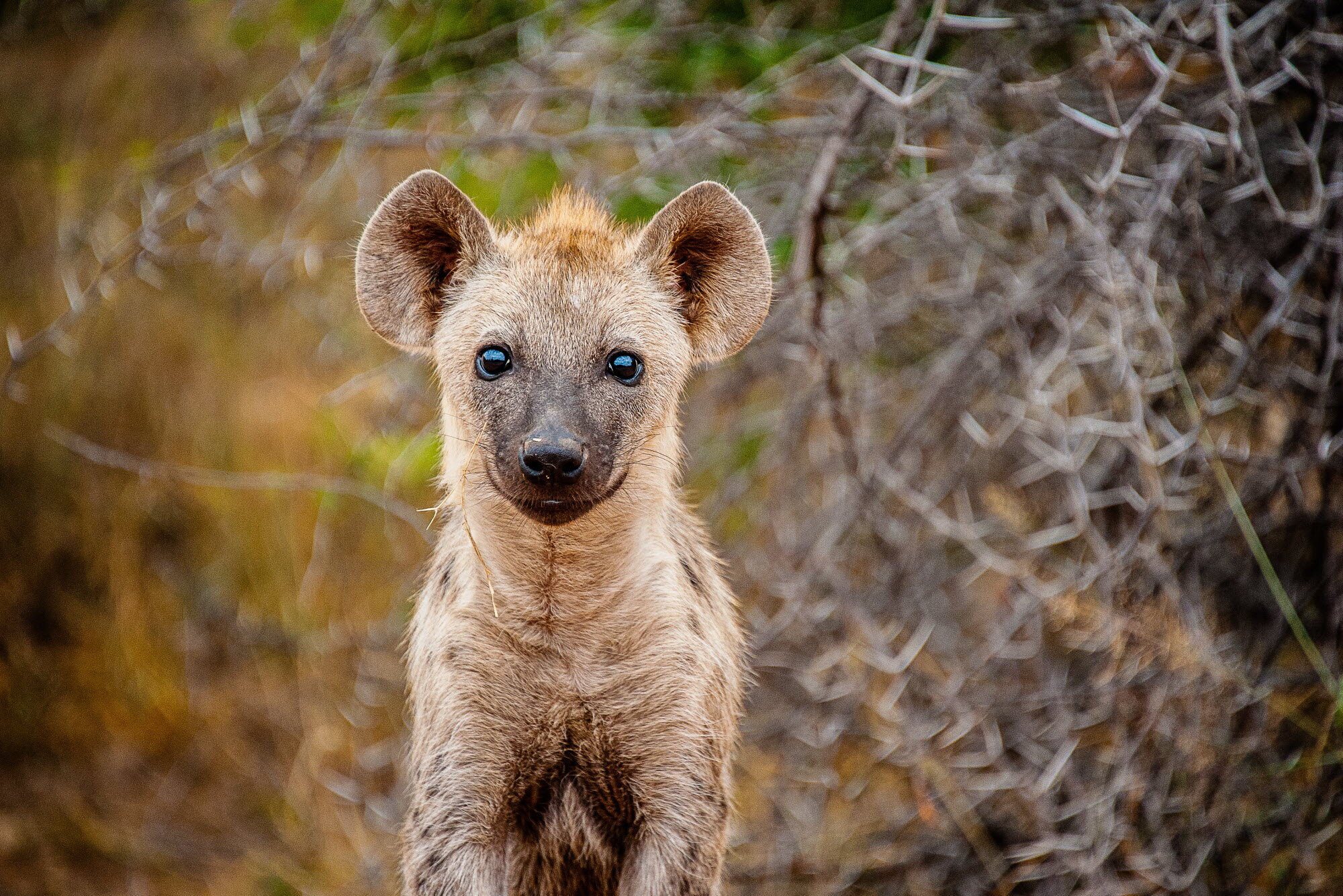10 AMAZING FACTS ABOUT HYENA
Hyena are one of the most misunderstood and under-appreciated species in the animal kingdom. Read 10 amazing facts about spotted hyena from our Wild Tomorrow South Africa Board member and hyena expert, a.k.a. “hyena man”, Axel Hunnicutt. Axel is a member of the IUCN Hyena Specialist Group and led a study on the spotted hyena and its regional decline in KwaZulu-Natal South Africa. After returning to the US, Axel is now the Statewide Gray Wolf Coordinator at the California Department of Fish and Wildlife.
A hyena pup at Kruger National Park. Photo credit: Shannon Wild/Wildscreen Exchange.
1. Hyenas are adept hunters
One of the longest-standing false accusations against the spotted hyena is that they are purely scavengers, particularly that they steal most of their food from lions. In fact, studies have shown that hyenas kill 66-90% of what they eat and are extremely versatile and successful hunters. As cursorial hunters, hyenas run down their prey to exhaustion, cruising at speeds of 37 mph (60 kph) for several miles. Spotted hyenas can bring down prey many times their size. For an animal the size of a large dog, it is amazing that they have been recorded killing cape buffalo and giraffes. As for the lions, who are the supposed providers for the inept hyena, multiple studies have shown the lions are more likely to scavenge from hyena kills, owing to the hyena's higher success rate.
Photo courtesy of Will Clothier
2. Hyenas are great mothers
When thinking of nature’s great mothers, a gorilla nestling her young baby in her arms or a cat nursing her kittens may come to mind; usually not a spotted hyena. However, hyenas, surprisingly, are some of the best mothers in the animal kingdom, investing more energy per cub than any other terrestrial carnivore. Hyenas give birth to 1 to 3 tiny jet-black cubs (some call them pups because early naturalists thought they resembled bear cubs). Genetically, hyenas are closely related to civets, genets, and mongooses, therefore falling within the cat group of carnivores, hence the use of the term “cub”. Hyena cubs are “precocial”, meaning they are born in a more advanced stage of development with their eyes open, teeth intact, and muscles ready to go, unlike many of the cat species where cubs are born largely blind and helpless for several weeks.
Photo by Axel Hunnicutt
Spotted hyena mothers produce extremely fat- and protein-rich milk (richer than any other terrestrial carnivore) and they produce a lot of milk for a long period of time. Hyena cubs are completely dependent on milk for the first six months of their lives and will continue to nurse for up to another year. All of that places a lot of stress on a single mother as hyenas do not cross-suckle, even between closely related females.
3. Hyenas are amazingly intelligent
Often cast as being foolish and dull, perhaps due to the misunderstanding of their laugh or giggle vocalization, spotted hyenas show incredible signs of intelligence that rival most wild animals in Africa. In fact, hyena intelligence is thought to mimic the evolution of our own intelligence, with complex social behaviors driving brain evolution. In experiments, spotted hyenas have even outperformed chimpanzees in collective or group problem solving, showing that in some ways hyena intelligence may even exceed some of the great apes in certain aspects. Anyone who has spent any time with spotted hyenas in the wild can attest to their curious and inquisitive behavior; - certainly anyone who’s had their car or house broken into by one. I’ve even observed rudimentary tool use by hyenas to achieve goals such as escaping from cage traps.
Photo by Axel Hunnicutt
4. Hyenas can count
Studies have shown that spotted hyenas can determine the number of other hyenas in a rival clan and decide their best course of action. Similarly, males looking to join a new clan will always join the clan with the least number of other males after doing a quick census. It may not be calculus, but spotted hyenas are able to count!
5. Female hyenas have complicated and unusual genitals
Arguably the worst false accusation against hyenas is that they are hermaphrodites. This is completely false, but there's a very good reason why it was thought to be true. Female spotted hyenas do, in fact, have a pseudo-penis and a pseudo-scrotum, both of which are convincingly similar to the male anatomy. The pseudo-penis is actually her clitoris, which has evolved to mimic the male’s anatomy with the entire urogenital track running through it. Females urinate, have sex, and give birth through this structure. The reason for this male mimicry is not completely understood, but it is thought that this could be rooted back to when spotted hyenas started evolving in a matriarchal system in which the females became bigger and dominated the males in every way in order to take in enough nutrients to raise their cubs in a competitive society. Exposure to high levels of testosterone as a female foetus resulted in the development female genitalia that changed outwardly to mimic those of males.
A subordinate adult female (right) displays her pseudo-penis in a social greeting to a more dominant, but younger sub-adult female (left). Photo by Axel Hunnicutt
6. Hyenas have powerful jaws
A bite that can kill and also crush bones. Spotted hyena jaws have evolved colossal masseter (jaw) muscles to be able to produce massive amounts of force in a specific section of their dentition: the molars and premolars. With the ability to exert over 1,100 psi or around 9,000 newtons (depending on the studies you read), spotted hyenas can crack open bones nearly 2½ inches in diameter. This allows hyenas to access the nutrient-rich marrow inside that is inaccessible to most other animals.
7. Hyenas are remarkably long-lived
Unlike dogs and other canine species which can live for 6-10 years or even wild felids like lions and tigers that can live to 10-15, spotted hyenas can get into their 20s in the wild, making them some of the longest-living terrestrial carnivores. It takes 35 months (about 3 years) to reach 95% skull maturity, which is one of the most protracted skull growths of large carnivores after sexual maturity. The longest recorded living spotted hyena was in captivity and lived to 41 years and 1 month old!
Photo courtesy of Richard Steyn
8. Hyenas have a history of conquering
Even in their current range, spotted hyenas are arguably one of the most successful large carnivores, ranging across most of continental Africa in a diverse range of habitats. However, 10-20,000 years ago, the Eurasian spotted hyena, which likely was the same species, if not a subspecies, of the hyenas we see today, ranged from the British Isles to Eastern Siberia. The spotted hyena dominated large portions of three continents and directly competed with humans for resources and caves. It’s even thought that the presence of hyenas in Siberia prevented the spread of humans into the Americas across the Bering Strait!
9. Hyenas are tremendously socially complex
Living in social groups called clans that can contain as many as 130 individuals, spotted hyenas are quite sociable. However, unlike a wolf pack or lion pride, hyenas are rarely all together at once and are often found by themselves or in small groups, only meeting up sometimes. This is called a “fusion-fission” society. These clans are made up of largely related females who are the most dominant, their cubs who take on the rank directly below their mother, and non-natal males who have immigrated from other clans once reaching sexual maturity. These immigrant males take the lowest social ranks, in order of their arrival to the clan, and are even outranked by newborn cubs, since rank is imposed by the mothers by force. This type of linear social ranking is extremely similar to old-world monkeys, but hyenas’ female dominance is quite unique for a large carnivore. Within the clan, there is a matriarch who is the most socially dominant female who leads the clan, but there is also a complex social network of friendships and even political alliances, which become even more apparent when the matriarch dies and a power vacuum ensues.
10. Hyenas are vocal
The spotted hyena has a vocal repertoire unlike any other carnivore, largely due to their complex social nature. Best known for their laugh or giggle, the spotted hyena has often been called the “laughing hyena”, but the laugh isn’t funny: in general it’s an expression of social anxiety and uncertainty.
The hyenas’ whoop is the next most common call and is heard throughout the night in places where they roam. There are several different whoops that all mean different things. It’s similar to a wolf’s howl as the hyena uses its whoop as a method of long-range communication. A whoop can travel more than 3 miles and also codes for the specific animal's identity.
In total, there are over 11 distinct vocalizations, with some scientists claiming there are up to 28. Regardless of the count, the presence of complex and diverse forms of vocal communication owes to a complex and intelligent animal.
For more facts and conversation about hyena, check out a replay of our 29 April 2020 livestream event below.
REFERENCES
Cooper, S. M. "The hunting behaviour of spotted hyaenas (Crocuta crocuta) in a region containing both sedentary and migratory populations of herbivores." African Journal of Ecology 28.2 (1990): 131-141.
Cooper, Susan M., Kay E. Holekamp, and Laura Smale. "A seasonal feast: long‐term analysis of feeding behaviour in the spotted hyaena (Crocuta crocuta)." African Journal of Ecology 37.2 (1999): 149-160.
East, Marion L., and Heribert Hofer. "Loud calling in a female-dominated mammalian society: I. Structure and composition of whooping bouts of spotted hyaenas, Crocuta crocuta." Animal Behaviour 42.4 (1991): 637-649.
Gasaway, W. C., K. T. Mossestad, and P. E. Standers. "Food acquisition by spotted hyaenas in Etosha National Park, Namibia: predation versus scavenging." African Journal of Ecology 29.1 (1991): 64-75.
Henschel, J. R., and J. D. Skinner. "The diet of the spotted hyaenas Crocuta crocuta in Kruger National Park." African Journal of Ecology 28.1 (1990): 69-82.
Henschel, J. R., and J. D. Skinner. "Parturition and early maternal care of spotted hyaenas Crocuta crocuta: a case report." Journal of Zoology 222.4 (1990): 702-704.
Hirst, Stanley M. "Ungulate-habitat relationships in a South African woodland/savanna ecosystem." Wildlife Monographs 44 (1975): 3-60.
Hofer, Heribert, and Marion East. "and the Commuting System of Serengeti Spotted Hyenas." Serengeti II: dynamics, management, and conservation of an ecosystem 2 (1995): 332.
Holekamp, Kay E., and Laura Smale. "Provisioning and food sharing by lactating spotted hyenas, Crocuta crocuta (Mammalia: Hyaenidae)." Ethology 86.3 (1990): 191-202.
Holekamp, Kay E., Sharleen T. Sakai, and Barbara L. Lundrigan. "The spotted hyena (Crocuta crocuta) as a model system for study of the evolution of intelligence." Journal of Mammalogy 88.3 (2007): 545-554.
Höner, Oliver P., et al. "The response of spotted hyaenas to long‐term changes in prey populations: functional response and interspecific kleptoparasitism." Journal of Animal Ecology 71.2 (2002): 236-246.
Kruuk, Hans. "Clan-system and feeding habits of spotted hyaenas (Crocuta crocuta Erxleben)." Nature 209.5029 (1966): 1257-1258.
Kruuk, Hans. The spotted hyena: a study of predation and social behavior. No. Sirsi) a102104. 1972.
Marchant, Jo. "Hyenas can count like monkeys." (2011).
Mills, Michael GL. "The comparative behavioral ecology of hyenas: the importance of diet and food dispersion." Carnivore behavior, ecology, and evolution. Springer, Boston, MA, 1989. 125-142.
Peters, G. "vocalizations in terrestrial carnivores." (1984).
Pienaar, U. de V. "Predator-prey relationships amongst the larger mammals of the Kruger National Park." Koedoe 12.1 (1969): 108-176.
Van Horn, Russell C., et al. "Behavioural structuring of relatedness in the spotted hyena (Crocuta crocuta) suggests direct fitness benefits of clan‐level cooperation." Molecular Ecology 13.2 (2004): 449-458.
Trevor Carnaby. “Mammals: specific questions - predators.” Beat about the bush - exploring the wild.(2017)







